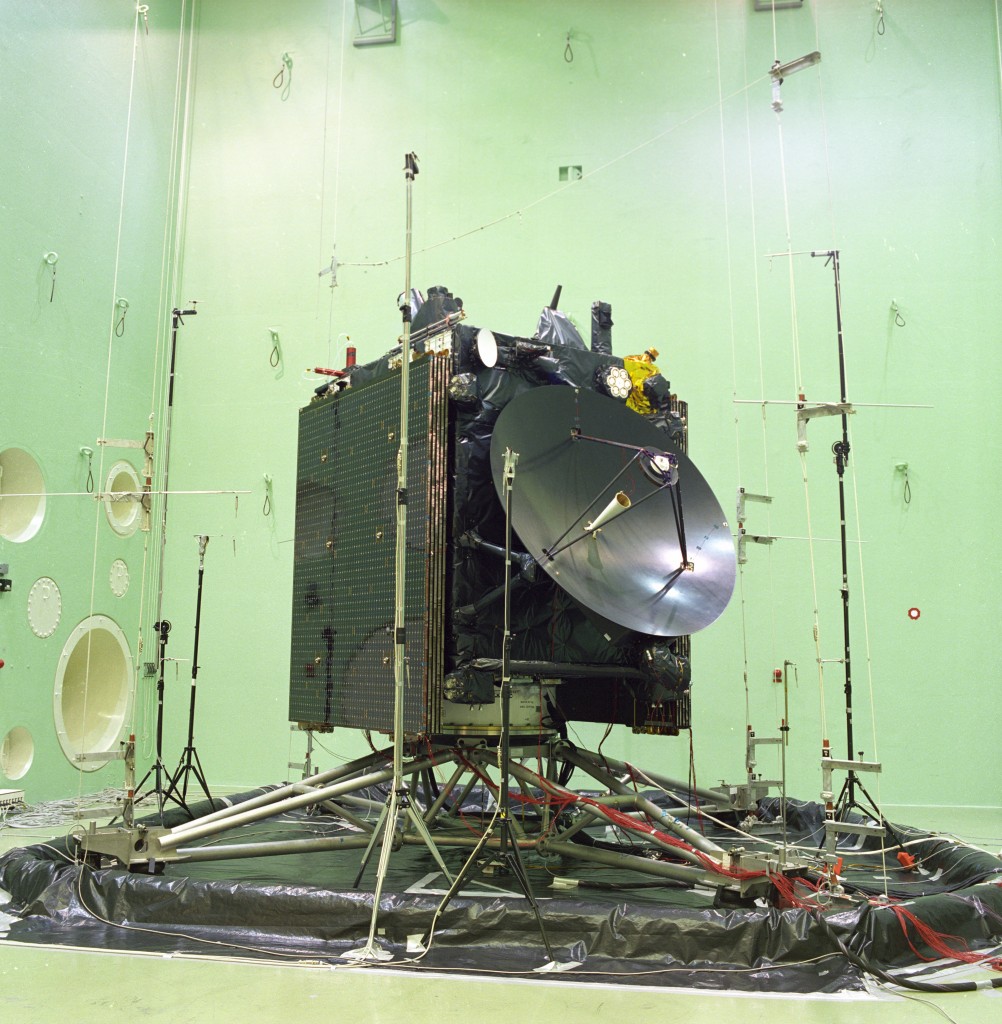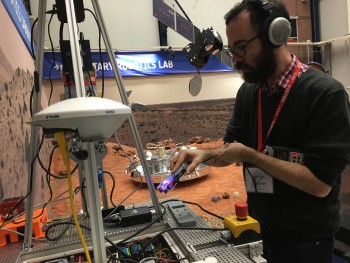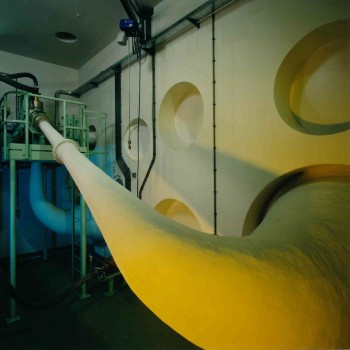Since both we at ESA and our colleagues at NASA opened our audio archives to the public, you know that you can actually listen to original sounds and sonifications from space.
Moreover, last year’s TEDxESA saw not just a one-of-a-kind performance by Berlin-based audio artist, journalist and technologist Peter Kirn remixing space sounds, Peter and myself also spent a good part of the day before TEDxESA touring ESA labs and test facilities, talking to scientists and engineers and collecting and recording as many sounds as possible. ESA and createdigitalmusic.com (CDM) are now making these sounds available to the public, ready to listen, download, use and remix (if you do so, please let us know!)

Rosetta in acoustic test chamber (Large European Acoustic Facility, LEAF). Image credit: ESA.
Using field recording techniques with both acoustic and electromagnetic microphones, impromptu sampling and archived sounds, we have compiled even more sounds that help us imagine the exploration of space.

Recording sounds at ESA ESTEC Planetary Robotics Lab. Image credit: ESA/M. Trovatello
First station: Sounds of ESA’s test centre
Spacecraft and satellites are quite expensive, and once in space they cannot be easily fixed. This is why they must be tested thoroughly before they are sent into space. The majority of ESA spacecraft are tested at the ESTEC Test Centre.
We started our tour at the LEAF, the Large European Acoustic Facility, where spacecraft such as Rosetta have been tested. Anyone who has ever witnessed a rocket launch will have been struck by the amount of noise produced – even when standing several kilometres from the launch pad. Of course a spacecraft on top of its launcher is exposed to much higher levels of acoustic noise. Long before it gets to that stage, its designers have to test that the satellite can withstand such a sustained sound – which we were lucky enough to catch.

A giant sound horn feeding into ESA’s acoustic test chamber LEAF. Image: ESA/A. Le Floc’h
Same test centre, different facility – and on to where spacecraft are shaken.
Shaken?
Yes, because while the LEAF covers the acoustic (and yet very physical, as Peter explains in the TEDxESA video above) part of testing spacecraft, there is of course also vibration testing, realised with electrodynamic and hydraulic shakers, and they produce interesting sounds too.
Here’s a set of sounds from ESA’s BepiColombo (due for launch to Mercury in 2017) and IXV spacecraft on the QUAD multishaker.
(Props and huge thanks Steffen Scharfenberg who works as Electro-mechanical engineer at ESTEC test centre for his time and dedication!)
Second station: Materials & Electrical Components Laboratory
On we went to tour ESA’s Materials & Electrical Components Laboratory, by invitation of fellow TEDxESA speaker Tommaso Ghidini (check him out: fascinating stuff on 3D printing, also on the Moon). Now listen to some nitrogen valves operating in a materials test:
Next stop: Planetary Robotics Lab
The longest recording session took place in ESTEC’s Planetary Robotics Laboratory (props and huge thanks to Martin Azkarate & team for their dedication and patience). Let’s listen to ESA’s ExoMars rover on its slow drive across the Lab’s artificial Mars surface…
… and the Rover’s camera (or more specifically its servo motors) operating as recorded by a special electromagnetic microphone
And, last but not least, on to the mildly humming inner-most electronic systems of the rover, also detected in the normally inaudible electromagnetic spectrum:
The recordings of the nitrogen valves and those made in the Planetary Robotics Lab were all produced with instruments custom-designed and built by electronic musician Jonáš Gruska of Bratislava. His “Uši” microphones were used to record sounds directly, while the “Elektrosluch” detects electromagnetic radiation and converts it to sounds we can hear. You can learn about his work at the LOM record label he runs from Slovakia.
One of the things that makes sound special as a medium is the fact that we can play with it.
So, as an example of what you can do with these materials, Peter produced a small sampled drum kit made from these recordings. That allows you to play the sounds as a kind of instrument, turning them into percussion. The recordings are available as plain audio files, and are also available as prepared instruments for Ableton Live and Native Instruments Machine. There’s also a set of sounds available in the iPad app Modstep. Drum Kits, plain audio files and are free to download and use – or adapt to your own instruments, if you so choose. Read the full article on the CDM Magazine: Get a free sampled drum kit made in a spacecraft test facility
We’re releasing these sounds under a Creative Commons licence to make sure you’re free to explore how they could be used. Sample them, remix them, put them in new contexts. As sounds of space exploration have begun to reach the public, we’ve already heard new and surprising (and fabulous!) things. We hope you’ll continue to surprise us. So send what you produce our way, and we can share it with others. And let us know what you want from future sounds, and how you might use them.
Update, 3 March
Peter Kirn/Create Digital Music have just published their full story (highly recommended read, of course): Free sounds are a window into space exploration on Earth
About
Peter Kirn is a musician and technologist, born in Kentucky and based in Berlin. He’s the creator of the site CDM (createdigitalmusic.com), where he covers the intersection of music-making and new tools. His own music spans experimental to techno, and he frequently works with building open platforms on which others can share ideas and tools. Follow him on Twitter: @peterkirn or @cdmblogs
Marco Trovatello works as Cross-Media Coordinator and Communication strategist at ESA Headquarters in Paris. He has spent his entire professional career in the public space sector (ESA and DLR, to be precise). Somehow he has managed to still follow some modest musical ambitions, played in various bands and released a solo album. Follow him on Twitter @marco_t

Discussion: no comments